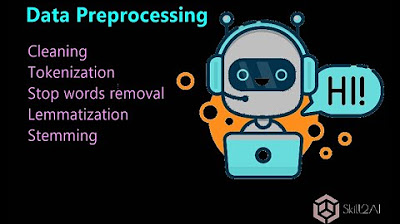Natural Language Processing - Tokenization (NLP Zero to Hero - Part 1)
Summary
TLDRThis video script introduces the concept of tokenization in natural language processing (NLP) using TensorFlow, aimed at beginners. It explains how words can be represented numerically for a computer to process, using ASCII encoding and word-based encoding to illustrate the process. The script demonstrates encoding sentences into a sequence of numbers, showing similarity between sentences with shared words. It also covers using TensorFlow Keras' tokenizer API in Python to tokenize text, manage exceptions, and prepare data for neural network processing, with an invitation to experiment with the provided code in Colab.
Takeaways
- 📚 The series is aimed at beginners in AI and ML, teaching NLP concepts from first principles.
- 🔤 The script introduces the concept of word representation for a computer using tokenization.
- 🔢 Words can be represented by numbers using encoding schemes like ASCII, but this can be problematic for understanding word sentiment due to letter order.
- 📝 It's easier to encode words rather than letters, which helps in training a neural network to understand their meaning.
- 🐶 The example 'I love my dog' is used to illustrate how sentences can be encoded into a sequence of numbers.
- 🔑 The 'num_words' parameter in the tokenizer API limits the maximum number of words to keep, useful for large datasets.
- 📖 The tokenizer fits to the text, creating a word index that maps words to tokens.
- 👀 The tokenizer can handle exceptions, such as punctuation, without creating new tokens for them.
- 💻 The script provides a code example using TensorFlow Keras to demonstrate the tokenization process.
- 🔄 The tokenized words are essential for preparing data in a format suitable for neural network processing.
- 🔑 The next step after tokenization is to represent sentences as sequences of numbers for neural network training.
Q & A
What is the main topic of the video series?
-The main topic of the video series is teaching natural language processing (NLP) using TensorFlow, starting from basic concepts for those who are not experts in AI or ML.
What is the process called that represents words in a way a computer can process them?
-The process is called tokenization, which involves representing words in a numerical form that a computer can understand.
Why is it difficult for a computer to understand sentiment just by the letters in a word?
-It's difficult because the same letters can form different words with different sentiments, such as 'listen' and 'silent', which have the same letters but different meanings.
What is an example of a word encoding scheme?
-An example of a word encoding scheme is ASCII, which represents letters with specific numbers.
How does the script suggest we should represent sentences for easier processing by a computer?
-The script suggests encoding words in a sentence rather than individual letters, assigning each unique word a numerical value.
What is the purpose of the 'num_words' parameter in the tokenizer object?
-The 'num_words' parameter is used to specify the maximum number of words to keep when tokenizing text, allowing the tokenizer to focus on the most frequent words.
How does the tokenizer handle exceptions like punctuation?
-The tokenizer is smart enough to ignore punctuation and not create new tokens for words followed by punctuation marks, treating them as the same word without the punctuation.
What is the result of the tokenizer's 'word index' property?
-The 'word index' property of the tokenizer results in a dictionary where the key is the word and the value is the assigned numerical token for that word.
What is the next step after tokenization in preparing data for a neural network?
-After tokenization, the next step is to represent sentences as sequences of numbers in the correct order, making the data ready for processing by a neural network.
Where can viewers find the code used in the video to experiment with tokenization?
-Viewers can find the code in a Colab notebook linked in the video description, where they can experiment with the tokenization process.
What will be covered in the next episode of the series?
-The next episode will cover tools for managing the sequencing of tokenized words, which is necessary for neural network processing.
Outlines

Этот раздел доступен только подписчикам платных тарифов. Пожалуйста, перейдите на платный тариф для доступа.
Перейти на платный тарифMindmap

Этот раздел доступен только подписчикам платных тарифов. Пожалуйста, перейдите на платный тариф для доступа.
Перейти на платный тарифKeywords

Этот раздел доступен только подписчикам платных тарифов. Пожалуйста, перейдите на платный тариф для доступа.
Перейти на платный тарифHighlights

Этот раздел доступен только подписчикам платных тарифов. Пожалуйста, перейдите на платный тариф для доступа.
Перейти на платный тарифTranscripts

Этот раздел доступен только подписчикам платных тарифов. Пожалуйста, перейдите на платный тариф для доступа.
Перейти на платный тарифПосмотреть больше похожих видео

Machine Learning #17 - Natural Language Processing (Pemrosesan Bahasa Alami)

Natural Language Processing In 5 Minutes | What Is NLP And How Does It Work? | Simplilearn

Text Preprocessing | tokenization | cleaning | stemming | stopwords | lemmatization

Natural Language Processing (Part 1): Introduction to NLP & Data Science

What is NLP (Natural Language Processing)?

Training a model to recognize sentiment in text (NLP Zero to Hero - Part 3)
5.0 / 5 (0 votes)
